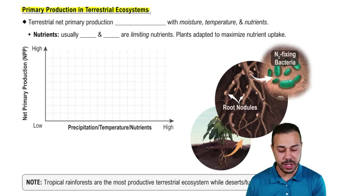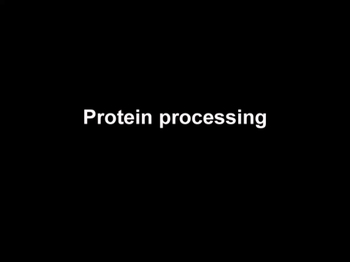Table of contents
- 1. Introduction to Biology2h 42m
- 2. Chemistry3h 40m
- 3. Water1h 26m
- 4. Biomolecules2h 23m
- 5. Cell Components2h 26m
- 6. The Membrane2h 31m
- 7. Energy and Metabolism2h 0m
- 8. Respiration2h 40m
- 9. Photosynthesis2h 49m
- 10. Cell Signaling59m
- 11. Cell Division2h 47m
- 12. Meiosis2h 0m
- 13. Mendelian Genetics4h 44m
- Introduction to Mendel's Experiments7m
- Genotype vs. Phenotype17m
- Punnett Squares13m
- Mendel's Experiments26m
- Mendel's Laws18m
- Monohybrid Crosses19m
- Test Crosses14m
- Dihybrid Crosses20m
- Punnett Square Probability26m
- Incomplete Dominance vs. Codominance20m
- Epistasis7m
- Non-Mendelian Genetics12m
- Pedigrees6m
- Autosomal Inheritance21m
- Sex-Linked Inheritance43m
- X-Inactivation9m
- 14. DNA Synthesis2h 27m
- 15. Gene Expression3h 20m
- 16. Regulation of Expression3h 31m
- Introduction to Regulation of Gene Expression13m
- Prokaryotic Gene Regulation via Operons27m
- The Lac Operon21m
- Glucose's Impact on Lac Operon25m
- The Trp Operon20m
- Review of the Lac Operon & Trp Operon11m
- Introduction to Eukaryotic Gene Regulation9m
- Eukaryotic Chromatin Modifications16m
- Eukaryotic Transcriptional Control22m
- Eukaryotic Post-Transcriptional Regulation28m
- Eukaryotic Post-Translational Regulation13m
- 17. Viruses37m
- 18. Biotechnology2h 58m
- 19. Genomics17m
- 20. Development1h 5m
- 21. Evolution3h 1m
- 22. Evolution of Populations3h 52m
- 23. Speciation1h 37m
- 24. History of Life on Earth2h 6m
- 25. Phylogeny2h 31m
- 26. Prokaryotes4h 59m
- 27. Protists1h 12m
- 28. Plants1h 22m
- 29. Fungi36m
- 30. Overview of Animals34m
- 31. Invertebrates1h 2m
- 32. Vertebrates50m
- 33. Plant Anatomy1h 3m
- 34. Vascular Plant Transport1h 2m
- 35. Soil37m
- 36. Plant Reproduction47m
- 37. Plant Sensation and Response1h 9m
- 38. Animal Form and Function1h 19m
- 39. Digestive System1h 10m
- 40. Circulatory System1h 57m
- 41. Immune System1h 12m
- 42. Osmoregulation and Excretion50m
- 43. Endocrine System1h 4m
- 44. Animal Reproduction1h 2m
- 45. Nervous System1h 55m
- 46. Sensory Systems46m
- 47. Muscle Systems23m
- 48. Ecology3h 11m
- Introduction to Ecology20m
- Biogeography14m
- Earth's Climate Patterns50m
- Introduction to Terrestrial Biomes10m
- Terrestrial Biomes: Near Equator13m
- Terrestrial Biomes: Temperate Regions10m
- Terrestrial Biomes: Northern Regions15m
- Introduction to Aquatic Biomes27m
- Freshwater Aquatic Biomes14m
- Marine Aquatic Biomes13m
- 49. Animal Behavior28m
- 50. Population Ecology3h 41m
- Introduction to Population Ecology28m
- Population Sampling Methods23m
- Life History12m
- Population Demography17m
- Factors Limiting Population Growth14m
- Introduction to Population Growth Models22m
- Linear Population Growth6m
- Exponential Population Growth29m
- Logistic Population Growth32m
- r/K Selection10m
- The Human Population22m
- 51. Community Ecology2h 46m
- Introduction to Community Ecology2m
- Introduction to Community Interactions9m
- Community Interactions: Competition (-/-)38m
- Community Interactions: Exploitation (+/-)23m
- Community Interactions: Mutualism (+/+) & Commensalism (+/0)9m
- Community Structure35m
- Community Dynamics26m
- Geographic Impact on Communities21m
- 52. Ecosystems2h 36m
- 53. Conservation Biology24m
4. Biomolecules
Proteins
Problem 4`
Textbook Question
The structural level of a protein least affected by a disruption in hydrogen bonding is the
a. Primary level.
b. Secondary level.
c. Tertiary level.
d. Quaternary level.
 Verified step by step guidance
Verified step by step guidance1
Understand the structural levels of proteins: Proteins have four levels of structure - primary, secondary, tertiary, and quaternary.
Identify the primary structure: The primary structure is the sequence of amino acids in a polypeptide chain, held together by peptide bonds.
Recognize the role of hydrogen bonds: Hydrogen bonds are crucial in stabilizing the secondary, tertiary, and quaternary structures of proteins.
Analyze the secondary structure: The secondary structure includes alpha helices and beta sheets, which are stabilized by hydrogen bonds.
Determine the least affected level: Since the primary structure is held together by peptide bonds and not hydrogen bonds, it is the structural level least affected by a disruption in hydrogen bonding.
 Verified video answer for a similar problem:
Verified video answer for a similar problem:This video solution was recommended by our tutors as helpful for the problem above
Video duration:
44sPlay a video:
Was this helpful?
Key Concepts
Here are the essential concepts you must grasp in order to answer the question correctly.
Protein Structure Levels
Proteins have four structural levels: primary, secondary, tertiary, and quaternary. The primary structure is the sequence of amino acids, the secondary structure includes alpha helices and beta sheets formed by hydrogen bonds, the tertiary structure is the overall 3D shape, and the quaternary structure involves multiple polypeptide chains. Understanding these levels is crucial for determining how disruptions affect protein structure.
Recommended video:
Guided course

Protein Structure
Hydrogen Bonding in Proteins
Hydrogen bonds are weak interactions that play a significant role in stabilizing the secondary and tertiary structures of proteins. They occur between the backbone atoms in the secondary structure and between side chains in the tertiary structure. Disruption of hydrogen bonds can lead to changes in protein folding and stability, affecting its function.
Recommended video:
Guided course

Hydrogen Bonding
Primary Structure Stability
The primary structure of a protein, which is the linear sequence of amino acids, is held together by covalent peptide bonds. Unlike hydrogen bonds, peptide bonds are strong and not easily disrupted by changes in environmental conditions. Therefore, the primary structure remains intact even when hydrogen bonding is disrupted, making it the least affected structural level.
Recommended video:
Guided course

Primary Production in Terrestrial Ecosystems
Related Videos
Related Practice























